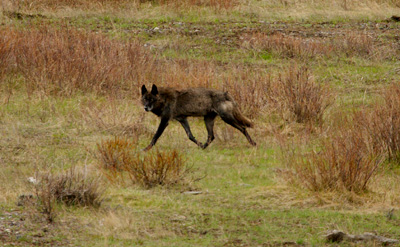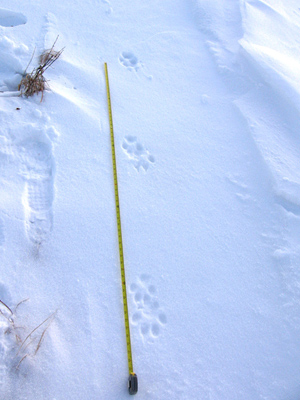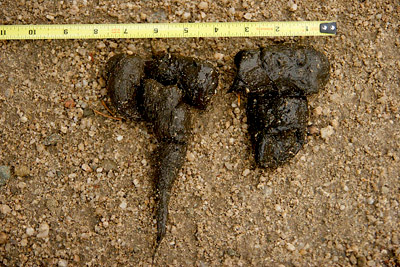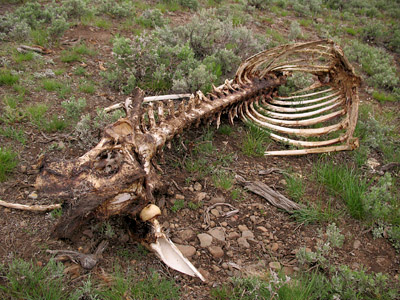Wolf Tracks & Sign

Wolf tracks and sign can be found in only certain
wilderness regions of North America.
Although they are highly adaptable, they have been heavily persecuted
for hundreds of years and are now limited to specific wilderness areas,
especially in the lower 48 United States.
Wolves eat a wide variety of things including fruits, reptiles,
amphibians, ground birds, small –to –medium mammals and large ungulates.
Tracks: Wolf tracks are large, relatively symmetrical. The tracks generally show 4 toes on both fronts and hinds. Wolves - like other canines – have 5 toes on their front feet. However, the 5th toe is small and higher up on the foot and usually does not register in the track. Each toe has a nail that generally registers in the track. Wolf tracks are generally so large, that they would be confused only with the largest breed of dogs. Wolves, however, tend to travel in very efficient, fairly straight paths through the landscape. Their tracks are also found in rather remote wilderness areas, not often traveled by very large domestic dogs. (Photo below by Mike Taras.)

Fronts are 3 3/4” – 5 3/4” long by 2 7/8” – 5” wide.
The negative space between the toes and the heel pad forms an H.
Rears are 3 3/4” – 5 1/4” long by 2 5/8” – 4 1/2” wide.
The negative space between the toes and the heel pad forms
an X. Overall, hinds are narrower and
more oval shape than the front.
Be More Prepared For Your Next Outdoor Adventure!

Don't leave without knowing these six essential survival skills. Our free survival mini guide reveals the strategies of:
- Shelter & fire to prevent the number one cause of death
- Obtaining clean water to avoid life-threatening dehydration
- Common wild survival foods and other critical skills!

Gaits: Wolves are
built to travel long distances.
They most often travel in a trot (equivalent to a human jog), either a side trot or a direct
register trot. Wolves can also walk, lope
and gallop. They will use different
gaits according to their needs and direct register trot for a wolf is between
22”-34” long and for a side trot it is 26”-39” long. The large feet and long legs make them well
adapted to snowy conditions. (Photo below by Mike Taras.)

Scat: Wolf scat is often large, ropey and tapered on one or both ends. These more typical scats are often composed of fur, bones, hide and meat. A scat made of all meat and internal organs can be rather amorphous in shape. Wolf scat can vary widely in length, from 6-17” long. In diameter, it tends to be between 1/2” to 1 7/8” wide. Like other canines, wolves use scat to mark territories and communicate to fellow wolves and other species about their presence, status, health and much more.

Other Sign: Wolves leave a variety of other sign behind. One of the most obvious is the remains found at kill sites of large ungulates. Wolves have very powerful jaws, with a bite force of up to 1,500 pounds per square inch. This is even more powerful than they bite strength of a spotted hyena (Crocuta crocuta) in Africa. This allows wolves to effectively bite through even the largest bones such as major leg bones of big ungulates like elk and moose. Notice how in this photo the leg bone of this elk was cleanly broken off and the marrow within it consumed. Bone fragments are common at wolf kill sites and wolves do consume some bones.

By the way, when you're out tracking or looking for wild animals, it's important to know how to stay safe in the outdoors, especially if you were to get lost. Right now you can get a free copy of our mini survival guide here, where you'll discover six key strategies for outdoor emergencies, plus often-overlooked survival tips.
Additional Resources on Wolf Tracks and Sign
Other Webpages about Wolf Tracks and Sign:
Recommend Books:
Mammal Tracks & Sign by Mark Elbroch
Wildlife of the Pacific Northwest by David Moskowitz
Tracking & The Art of Seeing by Paul Rezendes
Related Courses:
Wildlife Tracking Courses at Alderleaf

About the Author: Filip Tkaczyk is a periodic guest teacher at Alderleaf. He also wrote the field guide Tracks & Sign of Reptiles & Amphibians. Learn more about Filip Tkaczyk.
Return from Wolf Tracks back to Wildlife Tracking Articles
Is The Essential Wilderness Survival Skills Course Right for You? Take the "Online Survival Training Readiness" Quiz
See for yourself if this eye-opening course is a good fit for you. It takes just a few minutes! Get your Survival Training Readiness Score Now!

Grow Your Outdoor Skills! Get monthly updates on new wilderness skills, upcoming courses, and special opportunities. Join the free Alderleaf eNews and as a welcome gift you'll get a copy of our Mini Survival Guide.

 The Six Keys to Survival: Get a free copy of our survival mini-guide and monthly tips!
The Six Keys to Survival: Get a free copy of our survival mini-guide and monthly tips!
Learn more